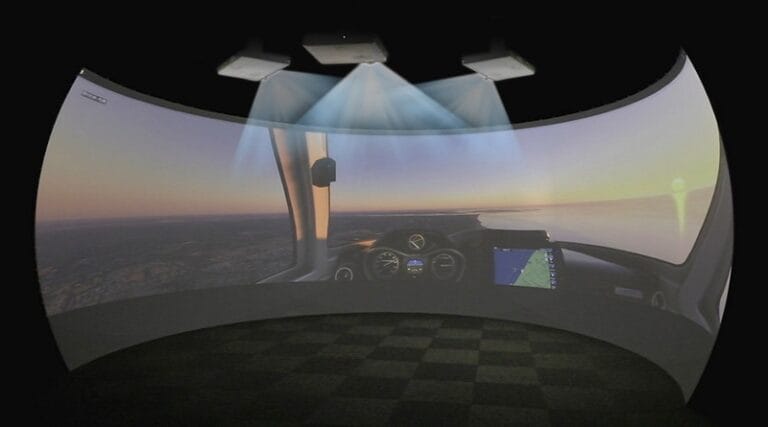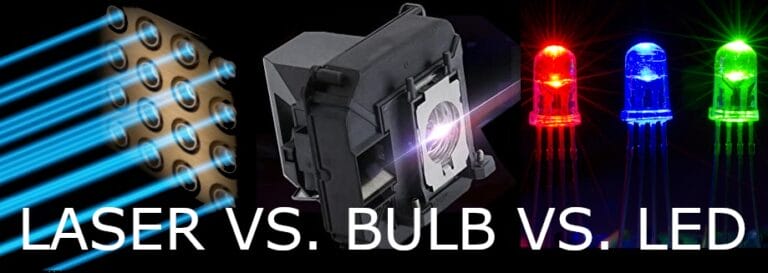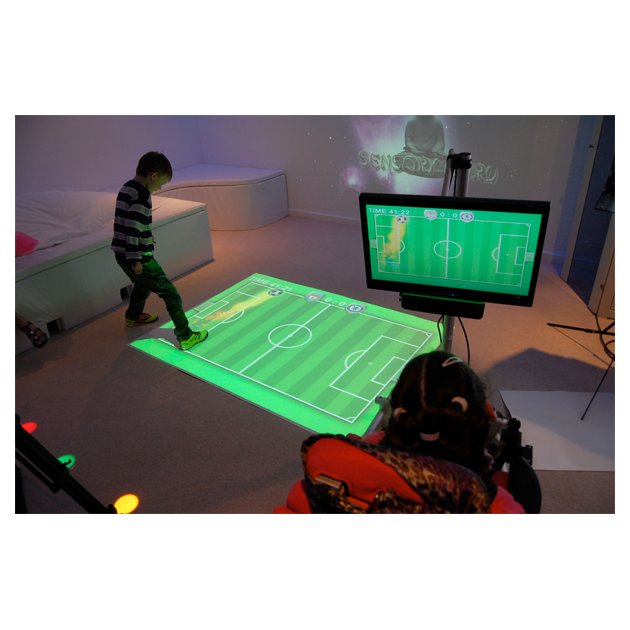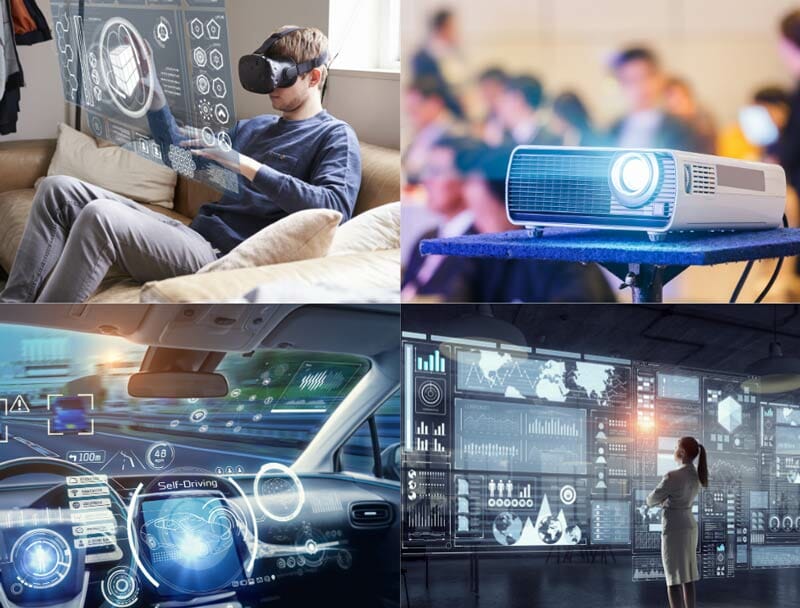
Futuristic technology is always intriguing, especially when it comes to projection. So, what is the future of projection technology? Let’s dive in and explore the exciting possibilities that lie ahead!
In today’s fast-paced world, we are constantly searching for new ways to bring our digital experiences to life. And projection technology is evolving at an astonishing pace, opening up a whole new world of immersive possibilities.
Imagine being able to turn any surface into a vibrant canvas, where you can watch your favorite movies, play video games, or even attend virtual meetings. The future of projection technology promises to make this a reality, captivating our senses and transforming our daily lives.
So, fasten your seatbelts as we embark on a journey into the world of projection technology, where imagination meets innovation, and the possibilities are truly endless. Get ready to witness the future unfold right before your eyes!
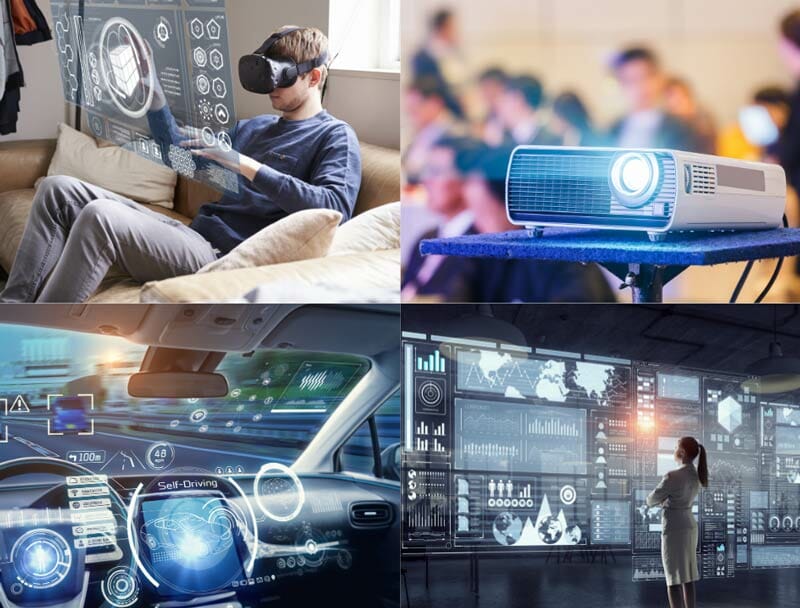
Future of Projection Technology
Projection technology has come a long way since its inception, revolutionizing the way we view and interact with visuals. As advancements continue to push the boundaries of what is possible, we are left wondering: What does the future hold for projection technology?
In this article, we will explore the exciting developments and trends that are shaping the future of projection technology.
From groundbreaking innovations to practical applications, let’s dive into the possibilities that lie ahead.
1. Miniature Projectors
The future of projection technology lies in miniature projectors, capable of delivering high-quality images in a compact form factor. These projectors are being integrated into smartphones, tablets, and even wearables, allowing users to conveniently share multimedia content wherever they go.
Powered by advanced LED technology and optical advancements, these mini projectors offer incredible versatility and portability. Whether it’s a business presentation on the go or a movie night under the stars, miniature projectors are set to transform the way we use and interact with visual content.
One potential application of miniature projectors is in augmented reality (AR) glasses. These glasses can project virtual objects and information directly onto the user’s field of view, creating a seamless blend of the real and digital worlds.
From interactive gaming and immersive storytelling to real-time navigation and information display, AR glasses powered by miniature projectors have the potential to revolutionize various industries, including entertainment, education, healthcare, and more.
Furthermore, miniature projectors are also making their way into smart homes and smart offices, enabling projection mapping on everyday objects. Imagine projecting a calendar onto your desk or turning your living room wall into a giant display for video calls.
The possibilities are endless, and with advancements in image quality, brightness, and resolution, miniature projectors are set to become an integral part of our daily lives.
2. Laser Projection
Laser projection is at the forefront of the future of projection technology, offering enhanced brightness, color accuracy, and picture quality.
Instead of traditional lamp-based projectors that use a combination of filters and mirrors, laser projectors utilize powerful lasers to create stunning visuals. With laser light sources, there is no need for lamp replacements, reducing maintenance costs and providing longer-lasting performance.
Not only do laser projectors deliver brighter images, but they also offer wider color gamuts, ensuring more accurate and vibrant hues.
This makes them ideal for applications in fields such as digital cinema, live events, and large-scale installations. The advancements in laser projection technology have made it possible to achieve high brightness levels even in well-lit environments, making it suitable for a wide range of applications beyond traditional projection settings.
In addition to its brightness and color capabilities, laser projection technology also offers improved energy efficiency.
Compared to traditional lamp-based projectors, laser projectors consume less power, making them more environmentally friendly and cost-effective in the long run.
As the technology continues to evolve, we can expect laser projectors to become the go-to choice for large-scale projections and immersive visual experiences.
3. 3D Projection Mapping
3D projection mapping has gained popularity in recent years, captivating audiences with mind-bending visual displays on various surfaces.
This technique involves projecting images and videos onto irregular shapes and structures, creating illusions of movement, depth, and transformation. While the concept of projection mapping is not new, advancements in technology are taking it to new heights.
One of the revolutionary developments in 3D projection mapping is the use of real-time tracking and mapping algorithms. With these algorithms, projectors can adapt the projected visuals to the contours of the object or surface in real time, ensuring precise alignment and seamless transitions.
This opens up endless possibilities for creating immersive experiences in live events, museums, architectural displays, and even interactive advertising campaigns. Imagine a building facade coming to life with dynamic animations or a car showroom where projected images bring various customization options to life.
Furthermore, the integration of augmented reality (AR) and 3D projection mapping is another exciting direction for the future. By combining virtual elements with real-world objects, AR and projection mapping have the potential to create captivating and interactive experiences.
Whether it’s overlaying information on a physical object or turning a tabletop into a dynamic playground, this convergence of technologies is set to redefine how we perceive and interact with our surroundings.
4. Ultra-High-Resolution Displays: Visuals Like Never Before
The demand for immersive and lifelike visual experiences continues to drive advancements in display technology. In the future, we can expect projection technology to deliver ultra-high-resolution displays that rival the clarity and detail of real life. These displays, powered by technologies like 8K and beyond, will elevate our viewing experiences to unprecedented levels.
With higher resolutions, projectors can create incredibly detailed and sharp images, allowing viewers to see intricate details that were previously impossible to discern.
From art exhibitions and scientific visualizations to virtual reality content and movie screenings, ultra-high-resolution displays will transport us into a new realm of visual immersion.
Beyond resolution, the future of projection technology will also focus on improving color reproduction and contrast ratios. HDR (High Dynamic Range) capabilities will enable projectors to deliver a wider range of colors and more nuanced shades, making the visuals more realistic and engaging.
Combined with advancements in image processing and upscaling algorithms, projection technology will continue to push the boundaries of what is visually achievable.
5. Interactive Projection: Engaging Experiences
Projection technology is evolving beyond passive observation, paving the way for interactive and engaging experiences. Interactive projection systems allow users to directly interact with the projected content, creating immersive and participatory environments.
From touch-based interactions to gesture and motion tracking, these systems enable users to manipulate and control the visuals in real time.
One example of interactive projection technology is interactive floor projection. By projecting images and interactive elements on the floor, users can engage in virtual games, interactive learning activities, or simply create captivating visual displays.
Another area of focus is immersive storytelling experiences, where users can step into a virtual world and actively participate in the narrative.
Furthermore, projection technology combined with augmented reality (AR) is unlocking new possibilities for interactive experiences.
By projecting virtual content onto real-world objects, users can engage with the virtual elements using AR devices, creating a seamless blend of physical and digital interaction.
This convergence of technologies is set to transform various industries, including gaming, education, marketing, and more.
6. Advancements in Projection Technology for Medical Applications
Projection technology is not limited to entertainment and visual experiences. In the medical field, it has the potential to revolutionize diagnostics, surgical procedures, and patient care.
Advanced projection systems can be used to display medical imaging data and vital signs directly onto the patient, eliminating the need for separate monitors and enhancing the efficiency and accuracy of healthcare professionals.
One example of this is in surgical procedures, where augmented reality (AR) can project real-time data, such as patient vitals, onto the surgeon’s field of view.
This allows for better decision-making and precision during surgeries, reducing the risk and improving patient outcomes. Additionally, projection technology can also be used in rehabilitation settings, where interactive projections can aid in physical therapy exercises and cognitive training.
As projection technology continues to advance, we can expect more innovative applications in the medical field, ranging from telemedicine consultations to advanced training simulations for medical professionals. These advancements have the potential to improve diagnostics, patient monitoring, and overall healthcare outcomes.
7. Projection Technology in Education: Transforming the Classroom
Projection technology is making its way into classrooms, transforming traditional learning environments into interactive and engaging spaces.
Interactive projectors and interactive whiteboards allow teachers to deliver dynamic lessons and promote student participation. Students can interact directly with the projected content, collaborate on projects, and explore complex concepts through interactive simulations and visualizations.
Furthermore, projection technology enables distance learning and remote education, bridging the gap between students and educators in different locations.
With high-quality video conferencing capabilities and shared visual content, students can participate in virtual classrooms and have access to the same learning resources as their peers. This opens up opportunities for lifelong learning, flexible education models, and global collaborations.
In addition to content delivery, projection technology can also serve as a tool for creating immersive learning experiences. 3D projections can transport students to historical landmarks or natural wonders, allowing them to explore and interact with the environment in a virtual setting.
Simulations and virtual laboratories can provide hands-on experiences in subjects like science, engineering, and medicine, enhancing understanding and knowledge retention.
Future of Projection Technology
As we venture into the future, the possibilities for projection technology are boundless. Miniature projectors, laser projection, 3D projection mapping, ultra-high-resolution displays, interactive experiences, medical applications, and educational advancements are just a fraction of what the future holds.
These advancements have the potential to reshape various industries and create new opportunities for creativity, communication, and innovation.
Whether it’s the seamless integration of projection technology into our daily lives, the transformation of visual experiences through immersive displays, or the use of projection technology in critical fields like healthcare and education, the future is bright.
Embracing these technologies and pushing the boundaries of what is possible will propel us into a future where projection technology truly becomes a ubiquitous part of our lives.
So, get ready to be amazed as the future of projection technology unfolds before our eyes, bringing us closer to a world where imagination and reality merge seamlessly.
Future of Projection Technology
- Projection technology is advancing rapidly.
- Smaller and more portable projectors are becoming popular.
- Projection quality is improving with higher resolutions and brighter images.
- Augmented reality and virtual reality applications will enhance projection experiences.
- Projection technology will continue to find new applications in various industries.
Frequently Asked Questions
Projection technology has come a long way, and its future looks quite promising. Here are some common queries regarding the future of projection technology:
1. How will projection technology evolve in the coming years?
In the coming years, projection technology is expected to become more advanced and versatile. We can anticipate improvements in resolution, brightness, and color accuracy, allowing for incredibly sharp and vibrant visuals.
Additionally, we may see the development of new projection techniques, such as holographic projections or transparent displays. The future of projection technology holds the potential to revolutionize industries like entertainment, education, and advertising.
Moreover, advancements in artificial intelligence and machine learning might lead to smart projection systems that can adapt to user preferences and environments, delivering personalized and immersive experiences.
As technology continues to evolve, we can expect projection devices to become smaller, more portable, and energy-efficient, making them accessible to a wider range of users.
2. Will projection technology replace traditional displays?
While projection technology offers unique advantages, it is unlikely to replace traditional displays completely. Traditional displays, such as TVs and monitors, have their own strengths, such as higher pixel density and more accurate color reproduction.
However, projection technology can provide larger screen sizes and the flexibility to project onto various surfaces, making it ideal for certain applications.
Projection technology will likely coexist with traditional displays, finding its niche in areas that require larger-than-life screens, such as cinemas, auditoriums, or outdoor events.
It may also find its way into new applications, such as augmented reality, where projected images can overlay real-world environments, enhancing immersion and interaction.
3. How will advancements in projection technology impact education?
The future of projection technology holds immense potential for transforming education. With advancements in resolution, interactive capabilities, and collaborative features, projection technology can revolutionize the way students learn.
It can enable immersive virtual field trips, engaging visual presentations, and interactive learning experiences that cater to different learning styles.
Additionally, projection technology can bridge geographical barriers, allowing students to connect with remote teachers or experts from around the world.
It opens up opportunities for remote learning and fosters global collaboration. By creating dynamic and visually stimulating learning environments, projection technology can make education more engaging, interactive, and effective.
4. What impact will projection technology have on the entertainment industry?
Projection technology is set to have a significant impact on the entertainment industry. With advancements in image quality and interactive capabilities, it can create immersive experiences in cinemas, theme parks, and live events.
Projection mapping techniques can transform ordinary surfaces into dynamic displays, enhancing storytelling and captivating audiences.
Moreover, projection technology can revolutionize home entertainment, providing users with cinematic experiences in the comfort of their own homes.
With ultra-short throw projectors and ambient light rejection technology, users can enjoy large-screen entertainment without the need for bulky equipment or dark rooms. The future of projection technology in entertainment promises to redefine how we experience movies, sports, and other forms of media.
5. Will projection technology become more affordable and accessible?
As with most technologies, projection technology is expected to become more affordable and accessible over time.
With advancements in manufacturing processes and economies of scale, the cost of projection devices is likely to decrease, making them more accessible to a broader range of consumers.
In addition, the rise of portable and miniaturized projectors has already made projection technology more affordable and convenient for personal use. This trend is expected to continue, allowing individuals to enjoy projection technology in their homes, offices, or on the go.
Furthermore, as the technology improves and becomes more mainstream, competition among manufacturers will also contribute to making projection devices more affordable for the average consumer.
Projection technology is getting smaller, sharper, and more immersive. We can expect to see projectors in everyday objects from our phones to our glasses. The future of projection technology is bright and full of exciting possibilities.


